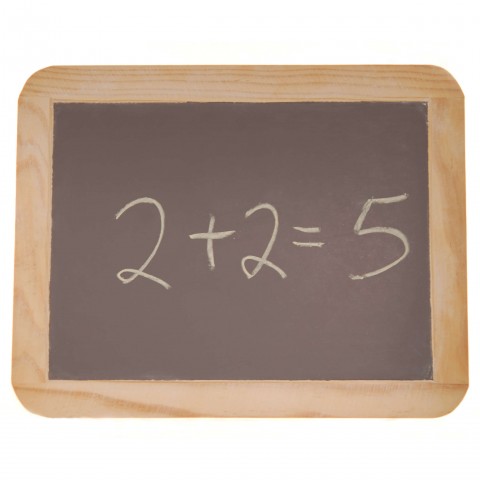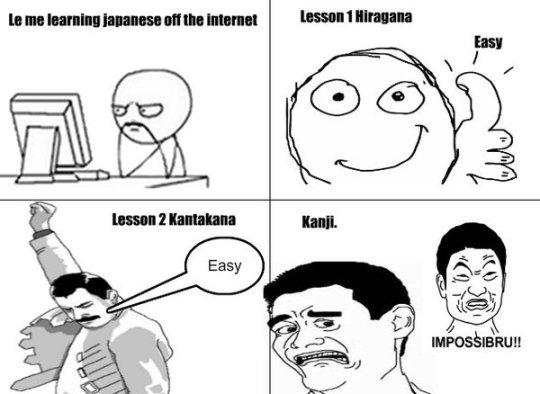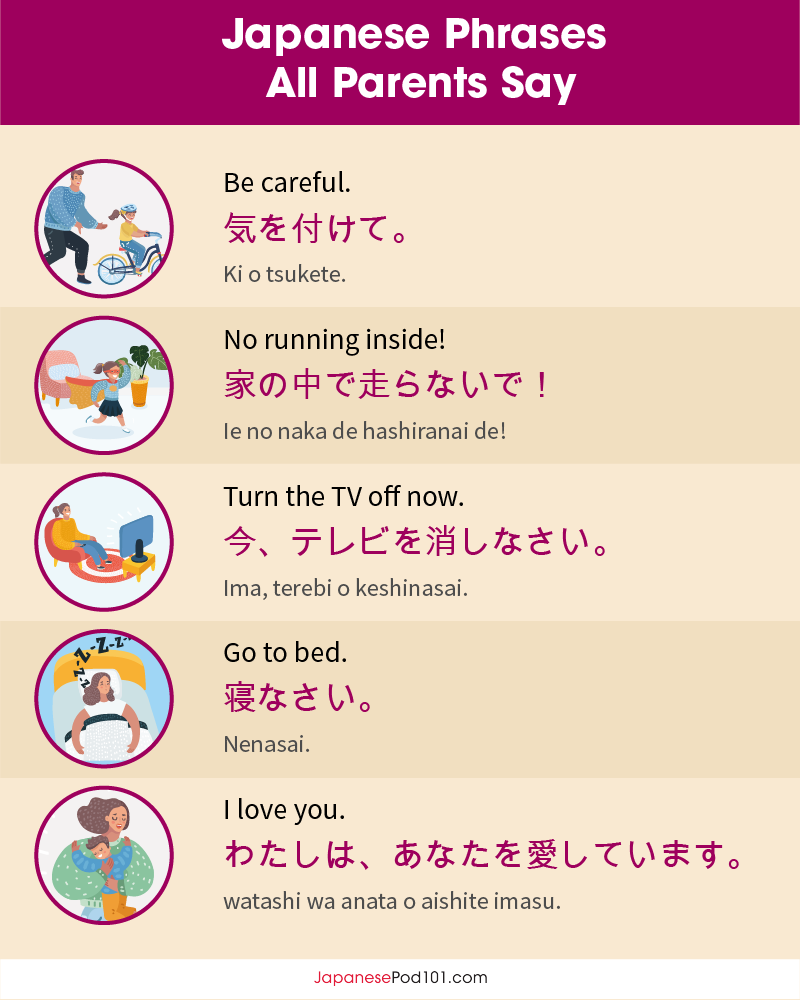
If you’re like most aspiring learners, you may be wondering: How long does it take to learn Japanese? Some people think that learning Japanese is too hard, that it takes forever and requires tremendous painstaking effort. But is that really true?
The answer to this question varies depending on multiple factors, such as your…
- …mother tongue.
- …educational background.
- …previous language learning experience.
- …level of interest and enthusiasm.
- …learning goals.
- …study methods.
In this article, we’ll give you some insight on how long it takes to learn Japanese for the different proficiency levels, keeping these influencing factors in mind. We’ll also provide tips to help you make the most of your study time.
Are you ready? Set your goals and join JapanesePod101.com on the first step of your language learning journey!

How long does it take to learn Japanese and how can you reach your goals faster?
 Table of Contents
Table of Contents
- Japanese Learning Overview
- How Long Does it Take to Achieve Beginner Level?
- How Long Does it Take to Achieve Intermediate Level?
- How Long Does it Take to Achieve Advanced Level?
- Conclusion
1. Japanese Learning Overview
Before we get into the details, let’s go over how the proficiency levels are defined. This will give you a good idea of what to expect at each stage of your learning journey and give you the knowledge you need to prepare accordingly.
Language Difficulty Rankings
The Foreign Service Institute (FSI) projects how difficult it will be and how long it will take for an English speaker to achieve a “Professional Working Proficiency” level in a given language. The difficulty levels are grouped into five categories, from the easiest languages (Category I) to the most difficult (Category IV). Category I languages are the most similar to English, and Category IV languages are the least similar.
Although the length of time needed to achieve proficiency can vary depending on many factors, FSI estimates the average approximate time for Category I languages to be 24-30 weeks (600-750 class hours). On the other hand, Category IV languages like Japanese take about 88 weeks (2200 class hours) to learn. Japanese is considered an “exceptionally difficult” language for native English speakers to master.
This assessment includes proficiency in reading, one of the most difficult parts of le/arning Japanese. The Japanese writing system is very different from the English alphabet, so many English speakers struggle to adapt.
That said, you can expect the learning process to be less difficult if your goal has more to do with speaking and listening (such as being able to make conversation and watch Japanese movies without subtitles). There are also some areas where Japanese is simpler than English, which can make learning the language a bit easier. For example, Japanese has fewer vowel and consonant sounds, simple rules for using tense, no plural form or articles, and no verb conjugations according to person.
- → Please see our article Is Japanese Hard to Learn? in order to discover the easiest and most difficult aspects of the language.
JLPT: Japanese-Language Proficiency Test
The JLPT (Japanese-Language Proficiency Test) is an official standardized criterion-referenced test that evaluates and certifies the Japanese-language proficiency of non-native Japanese speakers. It assesses language knowledge (grammar and vocabulary), reading ability, and listening ability.
The JLPT has five levels: N1 (the most difficult), N2, N3, N4, and N5 (the easiest).
| N1 | Advanced | The ability to understand all of the Japanese used in different everyday contexts. |
| N2 | Pre-Advanced | The ability to understand the majority of Japanese phrases used in different everyday contexts. |
| N3 | Intermediate | The ability to understand some of the Japanese phrases used in everyday situations. |
| N4 | Elementary | The ability to understand basic Japanese. |
| N5 | Beginner | The ability to understand some basic Japanese. |
The Japanese Language Education Center shows the study-hour data for JLPT by level, as well as the comparison between students with and without prior Kanji knowledge. The information indicates that students without prior Kanji knowledge will need more study time to reach each level.
[JLPT Study-Hour Comparison Data 2010-2015]
| Students with Kanji Knowledge (e.g. speakers of Chinese or Korean) | Students without Kanji Knowledge | |
| N1 | 1700~2600 hours | 3000~4800 hours |
| N2 | 1150~1800 hours | 1600~2800 hours |
| N3 | 700~1100 hours | 950~1700 hours |
| N4 | 400~700 hours | 575~1000 hours |
| N5 | 250~450 hours | 325~600 hours |

Make progress step by step to increase your language proficiency level.
Influencing Factors
That being said, there are numerous factors that influence how long it takes to learn Japanese.
Your Mother Tongue / Language Learning Experience
If your native language is similar to your target language, the learning process will be much faster and easier than if you tried learning a very different language. Likewise, if you have some language learning experience and are somewhat familiar with your target language already, this will definitely help you learn faster and more effectively.
In this regard, English speakers and learners unfortunately have little privilege when it comes to learning Japanese.
The classification of the Japonic languages (Japanese and its dialects) is still unclear, but many linguists see the Japonic languages as an independent family. Thus, Japanese doesn’t really have a family of close and similar languages, such as the Romance languages (Spanish, Italian, and French).
However, Japanese Kanji characters were originally brought from Ancient China and incorporated into Japanese. Although Chinese people cannot read or pronounce Japanese Kanji, they can often guess their meanings. While Chinese grammar and phonetics are very different from those of Japanese, the Korean language has some grammatical and phonetic similarities. Therefore, Chinese and Korean speakers (as well as learners of these languages) have a slight advantage when it comes to learning Japanese.
- → For more about the Japanese language, please see Japanese Language Overview: All the Facts You Need to Know.
Your Learning Goal / Motivation
What is your definition of ‘learning Japanese’ and what is your learning goal?
If your goal is to learn basic survival Japanese for traveling, then it won’t take very long to achieve. You would only have to learn some essential greetings and other useful phrases.
However, it would take a lot of time and effort to reach a level where you could watch Japanese movies and anime without subtitles, or speak fluently with Japanese natives. This requires good speaking and listening skills.
Learning to read and write high-level Kanji would also require a lot of time and effort. You would need to attain solid grammatical knowledge and gain a good command of Kanji. This would allow you to read Japanese newspapers and write official documents.
Whatever your learning goal may be, your motivation and enthusiasm play an important role as well. Whether you’re a big fan of Japanese culture and anime or you wish to live and work in Japan, your motivation impacts your level of commitment and your attitude toward learning Japanese. Your level of motivation determines how much time and effort you’re willing to dedicate to learning.
Study Method / Time You Dedicate to Learning
As the proverb says, “There is no royal road to learning.” The more time you spend, the more knowledge you get. The accumulation of small but continuous effort is important.
Even for the same hour spent on language learning, the results you’d get will differ depending on how you’re learning and how that time was used. For example, were you watching Japanese anime, reading a textbook, or talking with a Japanese teacher in class?
If you want to focus on daily conversations, then reading a textbook about grammar may not be the best learning method. You would probably fare better talking with a Japanese tutor online and watching Japanese movies with subtitles, as this would improve your speaking and listening skills faster.
Once you set your goal, try to find the best learning methods for your purposes. There are multiple options you can work on from your home, even if you’re outside of Japan. These include online lessons and online tutoring for more effective learning, and using YouTube and Netflix for a more laid-back and fun approach to studying.

Thanks to the internet, there are numerous ways we can learn from anywhere.
2. How Long Does it Take to Achieve Beginner Level?
Those who are thinking of starting to learn Japanese often wonder where to start, what to aim for as a beginner, and how long it will take to reach the beginner level. In this section, we’ll answer these questions and provide you with tips for how to learn Japanese effectively at this stage.
JLPT: N5 & N4 Levels
Even if you don’t take an actual exam, JLPT can be a good guideline to help you know what needs to be done to achieve a certain level. If you want to reach the N5 & N4 levels, you’ll need to build a foundation by learning the basic Japanese grammar and vocabulary.
N5 Level: Beginner
Reading
You should be able to…
- …understand typical daily expressions and sentences written in Hiragana, Katakana, and very basic Kanji.
[Example Exercise]
| A: あの 人 は だれ です か。 Ano hito wa dare desu ka. Who is that person? B: かれ は 田中さん です。 Kare wa Tanaka-san desu. He is Mr. Tanaka. |
Listening
You should be able to…
- …listen to and comprehend conversations about topics regularly encountered in daily life and classroom situations.
- …pick up necessary information from short conversations spoken slowly.
[Example Exercise]
| Listen to a question and a conversation and choose the best answer. — 男の人と女の人が話しています。男の人は何時に寝ましたか。 Otoko no hito to onna no hito ga hanashite imasu. Otoko no hito wa nan-ji ni nemashita ka. The man and the woman are talking. What time did the man go to bed? — (女/woman) 眠そうな顔してるね。 Nemusō na kao shiteru ne. You look sleepy. (男/man) 昨夜は遅くまで勉強していて。 Sakuya wa osoku made benkyō shite ite. I was studying until late last night. (女/woman) 何時ごろ寝たの? Nan-ji goro neta no? Around what time did you go to bed? (男/man) 3時半ごろ。 San-ji han goro. Around three thirty. |
N4 Level: Elementary
Reading
You should be able to…
- …read and understand passages on familiar everyday topics written in basic vocabulary and Kanji.
[Example Exercise]
| パスポート ばんごう を おしえて ください。 Pasupōto bangō o oshiete kudasai. Please tell me the passport number. ここ に あなた の うちの じゅうしょ を かいて ください。 Koko ni anata no uchi no jūsho o kaite kudasai. Please write your home address here. |
Listening
You should be able to…
- …listen to and comprehend conversations encountered in daily life and generally follow their contents (provided that they’re spoken slowly).
[Example Exercise]
| Listen to the question and answer options, and choose the best answer. — 仕事が終わって帰ります。何と言いますか。 Shigoto ga owatte kaerimasu. Nan to iimasu ka. (You) finished work and are going home. What do you say? おじゃまします。(Ojama shimasu.) お大事に。(Odaiji ni.) お先に失礼します。(Osaki ni shitsurei shimasu.) |
Native English speakers, or those who do not have previous Kanji knowledge, need approximately 325-600 hours of studying for N5 and 575-1000 hours for N4 level.
JLPT assesses mainly reading and listening skills, so you may need to put in some extra effort to write and speak at such levels.
How to Get to Elementary Level Faster
The most important thing for beginners to do is familiarize themselves with the Japanese language. You can get used to Japanese sentence structure, pronunciation, and basic vocabulary by doing simple exercises and repeating them until you feel comfortable with the content or concepts. With apps and online lessons, you can study anytime and anywhere.
Imiwa? and Japanese by Renzo Inc. are dictionary apps that allow you to look up any Japanese word you want to know. You can also use them to check the reading of Kanji, learn how to write Kanji, and see some usage examples.
The NHK Easy Japanese News app is a news app provided by Japan’s national broadcaster. It provides news articles written in simple sentences with 振り仮名 (furigana), or reading aid, for Kanji.
Online Lessons:
JapanesePod101.com offers informative yet fun audio and video lessons for absolute beginners. Together with grammar essentials, you’ll learn real and practical spoken Japanese. Our short and easy-to-understand lessons will keep you hooked from Level 1.

To learn a language, the output of knowledge is just as important as the input.
3. How Long Does it Take to Achieve Intermediate Level?
Depending on your goals, the next logical step is probably to learn even more and reach an intermediate level of fluency. So how long will it take you to learn Japanese to such an extent, and how can you get there?
JLPT: N3 Level
Reading
You should be able to…
- …read and understand written materials with specific contents concerning everyday topics.
- …grasp summarized information such as newspaper headlines.
- …read the kind of writing encountered in everyday situations that may be a bit more difficult, understanding the main points (as long as alternative phrases are available to you if needed).
[Example]
| 山本さんはクラスの代表に選ばれた。 Yamamoto-san wa kurasu no daihyō ni erabareta. Mr./Ms. Yamamoto was selected as a representative of the class. その会社は海外から輸入したバッグを日本で売っている。 Sono kaisha wa kaigai kara yunyū shita baggu o Nihon de utte iru. The company sells bags in Japan which they imported from abroad. |
Listening
You should be able to…
- …listen to and comprehend coherent everyday conversations spoken at near-natural speed, while following most of the spoken content and determining the relationships of the people speaking.
[Example Exercise]
| Listen to the question and answer options, and choose the best answer. — 試験に合格したので先生に伝えたいです。何と言いますか。 Shiken ni gōkaku shita node sensei ni tsutaetai desu. Nan to iimasu ka. (You) passed the exam and you want to tell this to the teacher. What do you say? 1 – 今回はおめでとうございます。(Konkai wa omedetō gozaimasu.) – Congratulations this time. 2 – 今度、合格なさいました。(Kondo, gōkaku nasaimashita.) – This time (he) passed. [in respectful form for others] 3 – おかげさまで、試験に受かりました。(Okage-sama de, shiken ni ukarimashita.) – Thanks to you, I passed the exam. |
For native English speakers, it’s estimated that around 950-1700 hours of studying is needed to achieve the N3 level.
How to Get to Intermediate Level Faster
To reach the intermediate level, you need to increase your knowledge of more complex grammar concepts and memorize a variety of everyday vocabulary words and phrases. In addition, it’s time to get used to the natural and native speaking speed. In order to achieve that, the amount of output is just as important as the amount of input—in other words, you need to practice active listening as well as speaking. Textbooks and lessons can only teach you so much!
Paper Materials:
Master intermediate-level grammar from your textbooks, and consider reading light novels and magazines to increase your daily input of Japanese.
Apps:
Wondering how to learn more Japanese vocabulary? Anki is an intelligent flashcard app that helps you memorize words more easily and increase your vocabulary.
Once you know the basics of how to compose Japanese sentences and have a solid vocabulary base, it’s time to start practicing. Hello Talk is a language exchange app that you can download on iOS or Android devices. With this app, you can find Japanese online friends to talk to.
Audio/Video Materials:
There’s a variety of audio/video sources for learning Japanese out there. YouTube and Netflix are easy options. Immerse yourself in Japanese-speaking environments every day—right from the comfort of your couch!
Need some recommendations? Then check out the following blog posts on JapanesePod101.com:
- ★ Top 10 Japanese YouTube Channels to Improve Your Japanese
★ Japanese Netflix Programs: Learn Japanese with Netflix
Online Lessons and Online Tutoring:
In addition to online lessons, useful vocab lists, and insightful articles on various topics, JapanesePod101.com provides a one-on-one tutoring service called MyTeacher. This service allows you to interact with your own personal teacher, who can help you personalize your learning program based on your progress and provide you with valuable feedback.

4. How Long Does it Take to Achieve Advanced Level?
Are you looking to become completely fluent in Japanese? Then be prepared to dedicate a lot of your time and effort to the task. This is a long journey, and you might begin to feel like you’re not progressing anymore no matter how much time you spend studying. Your progress may be slower than it was reaching the previous two levels, but every small effort counts. You’ll surely advance if you keep at it and don’t give up!
1. JLPT: N2 & N1 Level
N2 Level: Pre-Advanced
Reading
You should be able to…
- …read and comprehend clearly written content on various topics, including articles and commentaries in newspapers and magazines, as well as simple critiques.
- …read written materials on various topics, follow their narratives, and understand the writers’ intent.
[Example Exercise]
| (1) _____の言葉を漢字で書くとき、最もよいものを一つ選びなさい。 _____ no kotoba o kanji de kaku toki, mottomo yoi mono o hitotsu erabinasai. Choose the most appropriate one when the word _____ is written in Kanji. — 今日は、ゴミのしゅうしゅう日ですか。 Kyō wa, gomi no shūshūbi desu ka. Is it garbage collection today? 1. 拾集、2. 収拾、3. 修集、4. 取集 (2) ( )に入るのに、最もよいものを一つ選びなさい。 ( ) ni hairu no ni, mottomo yoi mono o hitotsu erabinasai. Choose the most appropriate one for ( ). — 日本人の平均( )は、男性が79歳、女性が86歳である。 Nihon-jin no heikin( ) wa, dansei ga 79-sai, josei ga 86-sai de aru. The Japanese average( )is male 79 years old and female 86 years old. 1. 生命、2. 寿命、3. 人生、4. 一生 seimei jumyō jinsei isshō |
Listening
You should be able to…
- …understand orally presented materials (coherent conversations, news reports, etc.) on a variety of topics and in different settings, spoken at nearly natural speed.
- …follow the main ideas and content of such materials.
- …understand the relationships of the people involved.
[Example Exercise]
| Listen to the sentence and choose the best reply. — あの、今、お時間よろしいでしょうか。 Ano, ima, o-jikan yoroshii deshō ka. Excuse me, do you have time now? [Can I talk to you?] 1 – えっと、4時5分ですよ。(Etto, yo-ji go-fun desu yo.) – Well, it’s 4:05. 2 – あいにく私も時計がなくて。(Ainiku watashi mo tokei ga nakute.) – Unfortunately, I don’t have a watch either. 3 – 10分くらいなら。(Juppun kurai nara.) – [Yes, I have] about ten minutes. |
N1 Level: Advanced
Reading
You should be able to…
- …read texts featuring complex logic or abstract ideas on a variety of topics (newspaper editorials, critiques, etc.) and comprehend their structure and content.
- …read texts featuring profound content on various topics, follow their narratives, and understand the writers’ intent.
[Example Exercise]
| (1) _____の言葉の読み方として、最もよいものを一つ選びなさい。 _____ no kotoba o yomikata to shite, mottomo yoi mono o hitotsu erabinasai. Choose the most appropriate reading for the word_____. — 彼は今、新薬の研究開発に挑んでいる。 Kare wa ima, shin’yaku no kenkyū kaihatsu ni _____iru. He is now challenging the research and development of new drugs. 1. はげんで、2. のぞんで、3. からんで、4. いどんで (2) ( )に入るのに、最もよいものを一つ選びなさい。 ( ) ni hairu no ni, mottomo yoi mono o hitotsu erabinasai. Choose the most appropriate one for ( ). — 私の主張は単なる( )ではなく、確たる証拠に基づいている。 Watashi no shuchō wa tan naru( )de wa naku, kakutaru shōko ni motozuite iru. My claim is based on solid evidence, not just ( ). 1. 模索、2. 思索、3. 推測、4. 推移 mosaku shisaku suisoku suii |
Listening
You should be able to…
- …comprehend spoken content in the form of conversations, news reports, and lectures in various contexts, when spoken at natural speed.
- …follow the ideas and understand the implicit meaning of such spoken content.
- …understand important details of such spoken content, including the relationships of those involved, logical structures, and essential points.
[Example Exercise]
| Listen to the sentence and choose the best reply. — 今日は、お客さんからの苦情が多くて仕事にならなかったよ。 Kyō wa, o-kyaku-san kara no kujō ga ōkute shigoto ni naranakatta yo. I couldn’t work much today because there were many complaints from customers. 1 – いい仕事、できて良かったね。(Ii shigoto, dekite yokatta ne.) – That’s good you have done a great job. 2 – 仕事、なくて大変だったね。(Shigoto, nakute taihen datta ne.) – It must have been tough without work. 3 – お疲れ様、ゆっくり休んで。(Otsukare-sama, yukkuri yasunde.) – You must be tired (well done), rest well. |
It’s estimated that it takes about 1600-2800 hours to achieve N2 and 3000-4800 hours to achieve N1. However, if you also want to master the Japanese Kanji of these levels, you’ll probably need to put in even more hours.
How to Get to Advanced Level Faster
At this point, you probably don’t have any issues with daily Japanese conversations. You just need to focus on expanding your high-level vocabulary, getting a good working knowledge of official and formal language (including different honorifics), and picking up some spoken colloquial language that’s not often found in ordinary textbooks or written documents. Below are a few ways you can speed up your learning process.
Paper Materials:
You can gain exposure to a wider range of vocabulary (including official words and technical terms) by reading more advanced paper materials. These include Japanese newspapers, magazines, and books on topics that interest you (business, biographies, IT, health, etc.).
Apps:
If you can, utilize all of the dictionary apps we mentioned earlier; this will surely take you to the next level. Kanji Senpai is another useful app that you can use to brush up on your Kanji skills by practicing and writing characters. Using news apps for daily reading is another effective way to learn official language.
Audio/Video Materials:
When using audio/video materials, try to focus on quality. Watching Japanese anime is fun and interesting, but it won’t take you to an advanced level. If you get bored of watching serious news channels and want something fun, you can choose to watch Japanese movies/TV shows in more complex genres (mystery, science fiction, crime thriller, techno thriller, etc.).
Online Lessons / Online Tutoring:
JapanesePod101.com offers plenty of more advanced online lessons in the form of written, audio, and video content. Our materials are designed to help you learn practical and natural Japanese in a fun and effective way. As an intermediate or advanced learner, you’ll greatly benefit from our one-on-one tutoring service MyTeacher; you’ll need the guidance and corrections of a native speaker in order to advance more quickly.

Reading newspapers will help you expand your vocabulary and reach an advanced level of Japanese.
Conclusion
In this article, we talked about how long it takes to learn Japanese by level and discussed a number of influencing factors. As you can see, the amount of time it takes you to learn the language has a lot to do with what your goals are: becoming a fluent speaker and listener will be much easier than mastering the Japanese reading and writing system.
If you would like to explore the Japanese language further, stay with JapanesePod101.com for the fastest and easiest way to fluency. With our variety of rich, free lessons and tools, your Japanese language skills will improve immensely.
Don’t forget that you’re not alone. When you use our MyTeacher service, your own teacher can always help you practice through personalized activities and assignments. You can also reach out to native speakers and your fellow Japanese learners through the JapanesePod101 forum!
Before you go, let us know in the comments if you feel ready to start learning Japanese. If not, we’d love to hear your questions or concerns, and we’ll be glad to help any way we can.
Now, it’s time to get started with JapanesePod101.com!

Being able to use appropriate business-level Japanese proves that you’ve achieved the advanced level.

Is Japanese Hard to Learn?

If you’re interested in learning the Japanese language but haven’t started yet, you may still be wondering: “Is Japanese hard to learn?” or “What are the hardest and easiest parts of learning Japanese?” No worries! We’ll explain everything you need to know about learning Japanese right here in this article.
Japanese is a unique and fascinating language. Although it’s spoken primarily in Japan, knowing the language is useful not only for fans of Japanese anime and manga, but also for those traveling in Japan. Even a basic understanding of Japanese will allow travelers to enjoy Japan’s wonderful culture to the fullest extent possible, and it’s essential for business if you’re interested in the Asian market.
Considering that Japanese is a major language with 128 million speakers, you can find plenty of language-learning resources. These can range from ordinary textbooks to subcultural “live” materials, such as content on YouTube and Netflix—not to mention the most useful online Japanese-learning platform, JapanesePod101.com!
In this article, we’ll introduce what it’s like to learn Japanese, including what makes Japanese difficult for some learners (and things that learners find pretty easy). We’ll also give you some tips on how to start learning Japanese in the fastest, easiest way possible.
Let’s get started!
 Table of Contents
Table of Contents
- Is it Hard to Learn Japanese?
- The Easiest and Hardest Parts of Learning Japanese
- Want to Learn Japanese? Here’s Where You Should Start!
- Why is JapanesePod101 Great for Learning Japanese?
- Conclusion

Fast, easy learning at JapanesePod101.com!
1. Is it Hard to Learn Japanese?
Or rather, is it hard for English-speakers to learn Japanese?
According to the language difficulty rankings by FSI (Foreign Service Institute), Japanese is a Category 5 language. This is the most difficult category, based on a scale of 1 to 5, and the ranking indicates how many hours of learning a native English-speaker would need to reach General Professional Proficiency in both Reading and Speaking.
However, the difficulty of Japanese for you depends on a number of factors, such as:
- Your learning goals
- Your mother tongue
- How interested you are in the Japanese language and culture
For example, if your learning goal is to be able to have daily conversations (speaking and listening), then learning Japanese may not be as difficult as you think. But if your goal is to be able to read Japanese newspapers and write business documents in Japanese, then keep in mind that this is an extremely difficult task for those who speak English or a Romance language (but fairly easy for Chinese- and Korean-speakers).
In addition, contrary to popular belief, spoken Japanese is said to be relatively easy to master when compared with other languages. Japanese has only five vowel sounds and thirteen consonant sounds, while English has twenty vowel sounds and twenty-four consonant sounds. Moreover, Japanese is a flat-sounding language which doesn’t use many tones or pitches. Thus, English-speakers and speakers of other non-tonal languages can easily learn how to speak and listen to Japanese!
2. The Easiest and Hardest Parts of Learning Japanese
In the following sections, we’ll go over the basics of what makes Japanese hard to learn (and how to overcome those issues). But first, let’s look at the easier aspects of Japanese!
A- What Makes Japanese Easy?
1 – Listening & Speaking
For most people, the goal of learning a new language is to be able to have conversations in that language. Conversation, as one of the most essential parts of communication, requires listening and speaking skills. In this regard, Japanese is actually an easy language to learn!
As mentioned in the previous section, Japanese is a flat-toned language with only five vowels and thirteen consonants. Compared to other languages that have more complex and difficult-to-pronounce sounds, as well as distinct tones and pitches, Japanese is rather simple.
English-speakers, who have already mastered twenty vowel sounds and twenty-four consonant sounds, will have little difficulty listening to and pronouncing Japanese words. (On the other hand, Japanese people always struggle to understand spoken English and pronounce English correctly. It’s difficult for Japanese people to tell the difference between word pairs like club and crab, bun and van, bowling and boring, etc.)
Even if you’re a beginner, you’ll be able to easily recognize and imitate Japanese sounds. There’s no need to be afraid of making mistakes here. Practice speaking as soon as you feel ready!

Speaking and listening are essential skills for conversation!
2 – Simple Grammatical Rules
No Article Needed
In Japanese, you don’t need to put an article in front of nouns. There’s no “a friend” or “the friend,” it’s just “friend,” or 友達 ともだち (tomodachi). How simple is that!
In English, you need to think about whether you should put “a” or “the” in front of a certain noun. Some Romance languages have even more complicated article variations, such as the Italian “un, una, la, le, il, lo, l’, gli, i.”
In Japanese, you only need to say the noun!
Words Don’t Change
In addition, Japanese words (nouns, adjectives, and verbs) do not change based on number, gender, or person. Japanese words are neutral, and there’s no feminine/masculine distinction that affects grammatical forms.
In English, “s” is usually added to a noun to make it plural (such as “friends“). And in Italian, nouns, articles, and adjectives change their forms according to the number (singular/plural) and the gender: mia amica é simpatica (“my friend is nice” – one female) / mio amico é simpatico (“my friend is nice” – one male) / miei amici sono simpatici (“my friends are nice” – plural).
These complicated rules don’t exist in Japanese! This also applies to Japanese verbs: there’s no variation of “is/are” or “do/does” in Japanese.
- 私の友達は親切です。
Watashi no tomodachi wa shinsetsu desu.
“My friend(s) is(are) kind.”
No matter how many people there are, and whether the person is female or male, words don’t change form in Japanese. Super-simple, right?
If you want to specify whether something is singular or plural, you only need to add a number or a word that expresses amount, such as “a few,” “many,” “hundreds of,” etc.
- 私は車を1台持っています。
Watashi wa kuruma o ichi-dai motte imasu.
“I have a car (one car).”
- 彼は1日にたくさんの本を読みます。
Kare wa ichi-nichi ni takusan no hon o yomimasu.
“He reads many books a day (in one day).”

Whether it’s one or three, “apple” is りんご (ringo) in Japanese, with no article.
Only Two Conjugation Exceptions
There are only two verbs that have irregular Japanese conjugation: する (suru), meaning “do,” and 来る (kuru), meaning “come.” Only two irregular verbs! Anyone can easily memorize them.
When you think about irregular verbs in English, the list is tremendously long: “be, go, come, eat, get, say, buy, run, know, take, put, read, send, meet, leave, pay, lay, think, teach, sing, ring, write, begin, drink, fly, draw, bring, feel, fall, have, hear, make, see, sit, shine, mean, stand, sleep….” and a lot more!
This is not the case in Japanese, so go ahead and let out a deep sigh of relief.
3 – Easy Tenses
There are only two tenses in Japanese: present and past. In order to mention something about the future in Japanese, use the present tense and add a word that indicates the future, such as “later,” “tomorrow,” “next month,” etc. In addition, Japanese does not have the perfect tense.
- 私は図書館へ行きます。
Watashi wa toshokan e ikimasu. [Present Tense]
“I go to the library.”
- 私は明日図書館へ行きます。
Watashi wa ashita toshokan e ikimasu. [Present + ashita (“tomorrow”)]
“I will go to the library tomorrow.”
- 私は図書館へ行きました。
Watashi wa toshokan e ikimashita. [Past Tense]
“I went to the library.”
When learning verb tenses, many people find that Japanese is much easier and simpler than English, which has multiple variations: “I go to / I’m going to / I will go to / I went to / I have been to / I have gone to / I had gone to …”
B- Why Japanese is Hard to Learn
1 – The Japanese Writing System
The Japanese language uses three different scripts: Hiragana (ひらがな), Katakana (カタカナ), and Kanji (漢字). This can be a bit confusing for beginners.
Hiragana is a phonetic system with forty-six characters which represent all of the sounds in spoken Japanese. It also includes a few variations which are closely related to specific characters and their sounds. For example, だ (da) is a variation of た (ta).
Katakana also has forty-six characters, which represent the same sounds as Hiragana. It is used mainly for writing words called 外来語 (Gairaigo), which are “imported” from foreign languages such as English. For example, アイスクリーム (aisu kurīmu) means “ice cream.”
Kanji originated from China and has been adopted by the Japanese language. Some Kanji characters are written using the same characters as in Traditional Chinese, but the way in which they’re used and read are unique to Japanese. For example, 新聞 means “newspapers” and it reads as しんぶん (shinbun) in Japanese. But these same characters mean “news” in Chinese, and are pronounced as xīnwén. It’s said that there are 3000-4000 Kanji characters, but there are only 2000 commonly used 常用漢字 (jōyō kanji) characters that are taught to children in schools.
If you’ve gotten the impression that the Japanese writing system is “a bit too complicated,” don’t worry too much!
The good news is that the Latin Alphabet is also used in Japan. Japanese people refer to it as ローマ字 (Rōma-ji), or “Roman letter,” and these letters are used to write a phonetic translation of Japanese words. People who have just started learning Japanese learn Hiragana and Katakana together with Rōma-ji.
In addition, all Japanese sounds end in a vowel (the only exception is ん [n]), and all of the Japanese syllables are very simple sounds. Every sound is written in Hiragana and Katakana. (There is no variation in the pronunciation of a given Japanese letter, such as “A” in the English words “family,” “agent,” and “away.”)
This will make Japanese pronunciation super-easy to learn! You just need to get used to Hiragana and Katakana and how their sounds are pronounced.
2 – Japanese is an SOV Language
A lot of English-speakers get confused with the Japanese word order.
The Japanese sentence structure is SOV, which means that the basic word order in a sentence is S (Subject) – O (Object) – V (Verb). English, on the other hand, is an SVO language: S (Subject) – V (Verb) – O (Object).
(S) (O) (V)
Japanese: Watashi wa toshokan e ikimasu. 私は図書館へ行きます。
( I / the library to / go. )
(S) (V) (O)
English: I go to the library.
The fact that Japanese verbs are always placed at the end of a sentence can be very confusing at first for SVO language-speakers.
You don’t know if it’s an affirmative sentence or a negative one until you hear the very end of that sentence, especially if a sentence is very long.
- 私は昨日友達と話した後に図書館へ行きませんでした。
Watashi wa kinō tomodachi to hanashita ato ni toshokan e ikimasen deshita.
( I / yesterday / friend / with / talked / after / the library / to / go / not / did )
= I did not go to the library after I talked to my friend yesterday.
You may find this aspect of Japanese easier if you remember that the verb (and its negator, if there is one) will always be at the end of the sentence.
However, asking questions in Japanese is consistent and very simple!
There’s no need to change the word order or add a new verb like in English: “She went to the library.” vs. “Did she go to the library?”
All you need to do is add か (ka) to the end of a sentence and say it with a rising tone.
- ➢ 彼女は図書館へ行きます。
Kanojo wa toshokan e ikimasu.
“She goes to the library.”
- ➢ 彼女は図書館へ行きますか。
Kanojo wa toshokan e ikimasu ka.
“Does she go to the library?”
See how easy that is?

Japanese is an SOV language: 彼女は図書館へ行きます (Kanojo wa toshokan e ikimasu.) – She (S) / the library (O) / to / go (V).
3 – Honorific Language
Japanese culture is famous for its politeness and respect, and this cultural aspect is reflected in the language: 敬語 (Keigo), or “honorific language.”
Apart from the casual language, Japanese has the three forms of Keigo, which are:
- 丁寧語 (Teineigo) – “polite language”
- 尊敬語 (Sonkeigo) – “respectful language”
- 謙譲語 (Kenjōgo) – “humble language”
You don’t need to be able to use all of these respectful forms perfectly for daily conversations as long as you can use the basic polite form. However, you’ll often hear Keigo in Japan as a customer or during official/business occasions.
The difficult thing about learning Keigo is that there are different expressions for verbs, and you need to use the appropriate words according to the level of politeness and the person whom you’re referring to.
You can use Teineigo (polite language) to express things politely for more general situations. However, you can neither use Sonkeigo (respectful language) for your own actions nor use Kenjōgo (humble language) for someone respectful (elders, boss, clients, honored person, etc.).
For example, there are three different expressions for “come”:
[ to come : 来る (kuru) ]
- Teineigo (general politeness): 来ます (kimasu)
彼は毎日ジムに来ます。
Kare wa mainichi gimu ni kimasu.
“He comes to the gym every day.”
- Sonkeigo (respectful expression for others): いらっしゃいます (irasshaimasu)
田中様は一時にいらっしゃいます。
Tanaka-sama wa ichi-ji ni irasshaimasu.
“Mr./Ms.Tanaka comes at one o’clock.”
- Kenjōgo (humble expression for yourself): 参ります/ 伺います (mairimasu / ukagaimasu)
私が書類を持って参ります。
Watashi ga shorui o motte mairimasu.
“I will come with the documents.”
If you would like to know more about Keigo and common honorific mistakes, please see our article about Common Japanese Mistakes.

Honorific language is one of the hardest parts of learning Japanese.
3. Want to Learn Japanese? Here’s Where You Should Start!
Now that you know what makes the Japanese language hard to learn (and which parts are easy), have you decided you want to learn it after all? Great! Here are some tips from JapanesePod101.com:
1. Get Motivated
The very first thing you should do is get motivated!
What do you want to do after you learn Japanese? Learn more about Japanese culture? Travel to Japan for work, study, or holiday? Watch Japanese anime and read manga in the original language? Make new Japanese friends?
With your interests and purpose in mind, set a learning goal to keep you motivated. It doesn’t need to be a big goal at first, like passing the advanced level exam, but a small goal you’ll be able to reach quickly.
A small learning goal is something you can work on without too much effort. Examples might include making new Japanese friends online, learning ten new words everyday, watching Japanese TV series everyday, traveling to Japan, or speaking to Japanese people when shopping.
The important thing is to stay motivated and accumulate your achievements in small chunks.
The more motivated you are, the faster you will learn!
2. Learn the Basics
When learning a new language, it’s essential to understand how it works first.
Once you learn the ground rules, such as the sentence structure and pronouns, then focus on learning useful sentence patterns that you can use in a variety of situations. With the most useful and common sentence patterns and phrases, you can adjust and adapt them for new situations as you build your vocabulary.
For beginners, our Top 100 articles are very helpful for building up your vocabulary with useful nouns, verbs, and adjectives. You can also use Flashcards to check and review everything you’re learning.
3. Input, Output, and Repeat
No one can do well at something they’ve never tried before! If you want to be able to speak, then listen, speak, and repeat as many times as possible. Learning by doing is the golden rule for mastering a language.
Japanese, as mentioned above, is easy to learn when it comes to listening and speaking, so you can start practicing at home from Day 1. Check the pronunciation of new words with audio using our Vocabulary Lists, and then repeat the word after the audio recording. After repeating a word or phrase several times, you’ll get used to the sounds and how to pronounce them.
If you’re living or traveling in Japan, you’re privileged with plenty of opportunities to practice in real life. Don’t be afraid, and make the most of your opportunities.
Even if you live outside of Japan, you can take advantage of the Internet age to access numerous learning materials, including JapanesePod101.com and our YouTube channel! You can even interact and practice with your own personal teacher using our MyTeacher program.
4. Have Fun!
To learn and improve your Japanese skills, it’s crucial that you study and practice hard. But don’t let yourself get too bored with traditional learning! Learning is more than studying at a desk with textbooks.
Entertain yourself while learning by watching Japanese movies and series, listening to music, reading comics and novels, etc.
Speaking, listening, reading, and writing are very separate skills, and you need to work on honing each one, depending on your goals. If your learning goal is, for example, focused on practical daily conversations, then such entertainment sources are very helpful. With video, audio, and subtitles, you’ll be able to learn a lot of practical vocabulary and phrases.
Also, check out our articles on how to learn Japanese with netflix and Anime! There are plenty of entertainment sources for learning Japanese.

Learn Japanese with entertainment!
4. Why is JapanesePod101 Great for Learning Japanese?
Many people think that Japanese is a difficult language, but this is only partly true. In reality, Japanese is a unique and interesting language which is actually easier to learn than you think. It’s just different from English, and learners require some strategic planning to learn it effectively.
JapanesePod101 offers a variety of effective and fun learning content for beginners and advanced learners.
1. Comprehensive and Practical Approach
JapanesePod101 offers a comprehensive and balanced approach to help you improve your listening, speaking, reading, and writing skills, step-by-step. We also offer focused lessons that look at a particular aspect of the language or culture. Each lesson has easy-to-understand information to keep you hooked.
Depending on your level, you’ll go through effective study materials with audio to improve your listening skills, practice pronouncing new vocabulary, and do writing exercises. Tests and quizzes will also help you check your knowledge.
After each lesson, you’re ready to move forward. Every lesson covers a practical topic or theme that you would encounter in everyday life in Japan.
2. Incredible Free Content
JapanesePod101.com is free but surprisingly affluent with information! We offer a wide range of rich content for learners at every level.
Before beginning your lessons, you may want to take a placement test that will give you a better idea of where to start. Every level has multiple lessons that follow a storyline designed to keep you engaged and learn natural Japanese.
Our free content includes themed vocabulary lists, customizable flashcards to practice your vocabulary, and a dictionary tool where you can search for a word by Latin Alphabet (Rōma-ji) or Japanese. Some of these features can be downloaded onto your computer so you can use them offline!
3. Your Own Teacher
Along with the lessons, our Premium MyTeacher service can accelerate your learning. Yes, you can have your own Japanese teacher by upgrading your account!
With MyTeacher, you can practice your speaking, reading, and writing through interaction with your private teacher. You’ll get personal feedback and tips on how to improve your pronunciation and writing skills. This personalized program and weekly assignments will keep you going, and you’ll also have full access to our self-study learning system.
5. Conclusion
In this article, you’ve learned the answer to “Is Japanese hard to learn?” Learning Japanese is not as difficult as you may think, especially if your goals are focused on verbal communication.
If you would like to explore the Japanese language further, stay with JapanesePod101.com for the fastest and easiest way to fluency. With a variety of rich, free lessons and tools, your Japanese language skills will improve immensely.
Don’t forget that you’re not alone. When you use our MyTeacher service, your own teacher can always help you practice through personalized programs and assignments.
Before you go, let us know in the comments if you feel ready to start learning Japanese. If not, we’d love to hear your questions or concerns, and we’ll be glad to help any way we can.
Now, it’s time to get started at JapanesePod101.com!

Learn About the Common Japanese Mistakes Students Make

Making mistakes is a matter of course when learning a new language. It’s actually good to make a lot of mistakes, because as you learn from correcting them, you’ll deepen your understanding of the language.
There are many common mistakes in Japanese that are easy for new learners to make. This is due to Japanese honorifics (which are unfamiliar to many learners), the various forms of postpositional particles, different grammar structures than in English, and so on. Although it seems complicated at first, once you get used to the patterns, you’ll surely improve your skills and know how to correct yourself when you make a mistake in Japanese.
In this article, we’ll introduce the most common mistakes people make when learning Japanese. Being able to spot these mistakes in Japanese is a sure sign of improvement! Let’s get started here at JapanesePod101.com!
 Table of Contents
Table of Contents
- Common Japanese Pronunciation Mistakes
- Vocabulary Word Mistakes
- Word Order Mistakes in Japanese
- Japanese Grammar Mistakes
- Honorific Mistakes
- The Biggest Mistake
- Conclusion: How JapanesePod101 Can Help You Learn More Japanese

Mistakes help you learn.
1. Common Japanese Pronunciation Mistakes
Japanese pronunciation mistakes often trip up new learners, so we’ll be covering these first!
1 – Shortening Long Vowels
Shortening long vowels is one of the most common mistakes that Japanese learners make.
All of the Japanese sounds, called ひらがな (Hiragana), always end with a vowel, except for ん (n):
- あ(a)
- い (i)
- う(u)
- え(e)
- お(o)
When the same vowel sounds are next to each other, you pronounce it long.
Examples
- Mother: お母さん / おかあさん – oka・a・san = “o-kā-san” [pronounce “a” longer]
- Far: 遠い / とおい – to・o・i = “tōi” [pronounce “o” longer]
Please pay attention when you’re pronouncing a word, because shortening the vowel can change the word’s meaning. For example:
- おばあさん – oba・a・san = “o-bā-san” [pronounce “a” long, it means “grandmother” / “old woman”]
- おばさん – oba・san = “oba-san“ [pronounce “a” short, it means “aunt” / “middle-aged woman”]
2 – Pronouncing Imported Words with an English Accent
カタカナ (Katakana) is one of the Japanese writing systems. It’s used for Japanese words not covered by 漢字 (Kanji), especially for foreign language words—外来語 (Gairaigo), or loan words—transcribed into Japanese.
Most Japanese learners may think Katakana is very simple and easier to use than Kanji or even Hiragana. However, you need to be careful when it comes to pronunciation.
Although most of the foreign words can be written in Katakana, make sure you pronounce them the Japanese way!
Examples
- Hamburger: ハンバーガー (hanbāgā) = pronounce it as “ha・n・baa・gaa”
- Christmas: クリスマス (kurisumasu) = pronounce it without intonation
- Orange: オレンジ (orenji) = pronounce each Katakana, as in “o・re・n・ji”
- Ticket: チケット (chiketto) = pronounce consonants and following vowels
Please note that the following word pairs are written in the same Katakana, and are pronounced the same way.
- bath / bus: バス (basu) = pronounce each Katakana, as in “ba・su”
- track / truck:トラック (torakku)
- coat / court: コート (kōto) = pronounce “ko” longer.

ハンバーガー (hanbāgā), or “hamburger” = pronounce it as “ha・n・baa・gaa”
3 – Stressing the Wrong Syllables
More common Japanese language mistakes occur when a new learner stresses the wrong syllables of a word.
Examples
- waTAshi わたし
- KOnNIchiwa こんにちは
- DŌ iTAshi MAshite どういたしまして
- SUshi すし
- tenPUra てんぷら
Listen carefully to how native speakers pronounce Japanese words. You’ll notice that most Japanese words lack strong intonation, and are rather flat.
To check the pronunciation of Japanese words, listen to the audio for the 50 Most Common Nouns and Top 10 Hardest Words to Pronounce.
4 – Pronouncing the “R” Sound in Japanese Incorrectly
The Japanese syllabaries Hiragana and Katakana represent syllables and sounds that are totally different from the alphabet and its sounds. Some alphabet sounds can’t be precisely expressed in the Japanese syllabary.
Some of the most confusing sounds may be: ら・り・る・れ・ろ. These are written as “ra, ri, ru, re, ro” in alphabet letters. Keep in mind that you should not roll your tongue when pronouncing the Japanese “r.” It actually sounds closer to the “L” sound.
Examples
- glass: グラス (gurasu) = Even though the original word is “gLass,” it is “guRasu” in Japanese.
- apple: りんご (ringo) = It’s pronounced more like “li.”
- travel: 旅行/りょこう (ryokō) = You don’t roll your tongue to say “ryo.”
- rule: ルール (rūru) = It’s pronounced more like “lu・u・lu,” with the “u” in the middle pronounced longer.

Pay attention when you pronounce “ら (ra) 、り (ri) 、る (ru) 、れ (re) 、ろ (ro)”, such as in りんご (ringo), meaning “apple.”
2. Vocabulary Word Mistakes
Now we’ll go over a few common Japanese mistakes that learners make concerning vocabulary. Pay close attention!
1 – Saying “You” in Japanese
“You” in Japanese is あなた (anata). Unlike English, Japanese doesn’t usually use this pronoun during conversations. The subject or object in a sentence can usually be omitted, especially in casual situations.
Examples
- 窓を開けてくれますか。
Mado o akete kuremasu ka.
“Can (you) open the window?”
- これあげます。
Kore agemasu.
“(I) give (you) this.”
- マリの今日の服かわいいね。
Mari no kyō no fuku kawaii ne.
“Mari’s outfit today is pretty.” (instead of “Your outfit today is pretty.”)
Japanese people use the name of the person they’re speaking to instead of using “you.”
2 – Using the Wrong “I”
Personal pronouns in Japanese are rich in expression, especially the first- and second-person pronouns. There are dozens of expressions for “I,” depending on the gender, politeness, formality, and how you want to express yourself.
Using the wrong word for “I” in a given situation is one of the most common mistakes that Japanese learners make.
Examples
- “I am Kaori Tanaka.” [In a formal occasion when the subject is female]
Wrong: 俺は田中かおりです。(Ore wa Tanaka Kaori desu.)
Correct: 私は田中かおりです。(Watashi (or Watakushi) wa Tanaka Kaori desu.)
- “I am a student.” [In a casual occasion when the subject is male]
Wrong: あたしは学生です。(Atashi wa gakusei desu.)
Correct: 僕 / 俺は学生です。(Boku / ore wa gakusei desu.)
Following are the most frequently used first person pronouns.
| Reading | Kanji | Hiragana | Level of Formality | Gender | Characteristics |
| watakushi | 私 | わたくし | very formal | both | This is a very formal and polite personal pronoun that’s often used in official occasions. |
| watashi | 私 | わたし | formal / informal | both | This one is used by both genders in formal occasions, such as in the workplace. This is the most commonly used word for “I,” but it’s often omitted in sentences. In informal situations, this is typically used by women. |
| atashi | ー | あたし | informal | female | This is the casual version of watashi, and it’s used by younger females in conversations. However, it can sound a bit childish and unsophisticated. |
| boku | 僕 | ぼく | informal | male | This pronoun is used by males of all ages, but very often by kids and younger men. It gives an impression of humbleness. This can also be used as a second-person pronoun toward little boys (English equivalent: “kid”). |
| ore | 俺 | おれ | very informal | male | This is frequently used by men in informal settings, such as among family and friends. It sounds very masculine. This can be rude when it’s used in formal occasions or in front of respectable/senior people. |
3 – Using the Wrong Casual Language
There are some sentence-ending particles in Japanese which are colloquial expressions and used only in casual situations.
Some are feminine and used by females, such as:
- -よ (-yo)
- -わ (-wa)
- -わよ (-wa yo)
And some are masculine, such as:
- -ぜ (-ze)
- -だぜ (-da ze)
Such sentence-ending particles don’t have a particular meaning; they just add emphasis or a sense of femininity or masculinity.
Make sure you use the correct suffix, otherwise you’d sound very strange!
Examples
- “I cleaned it.” [When the subject is a man]
Wrong: 私が掃除したわよ。(Watashi ga sōji shita wa yo.)
Correct: 俺が掃除したぜ。(Ore ga sōji shita ze.) [it sounds a bit rough]
- “It’s okay!” [When the subject is a woman]
Wrong: いいぜ!(Ii ze!)
Correct: いいわよ!・いいわ! (Ii wa yo! / Ii wa!)

俺が掃除したぜ。(Ore ga sōji shita ze.) = “I cleaned it.” – in a masculine and slightly rough manner
3. Word Order Mistakes in Japanese
You probably know already that Japanese uses a different sentence structure and word order than English. Many Japanese language mistakes by English-speakers have to do with word order confusion.
1 – Japanese is SOV
The word order of Japanese sentences may be confusing for learners whose native language is an SVO type, because the Japanese sentence structure is SOV: S (subject) – O (object) – V (verb).
(S) (O) (V)
Japanese: Watashi wa ringo o tabemasu. 私はりんごを食べます。
(S) (V) (O)
English: I eat an apple.
When it comes to making a negative sentence, the word indicating negativity comes at the end of the sentence.
Japanese: Kyō watashi wa ringo o hitotsu mo tabemasen. 今日私はりんごを一つも食べません。
[Literal meaning] today / I / apple / any (even one) / eat / not
English: I did not eat any apples today.
Make sure you don’t get confused and try to say: Watashi wa tabemasen hitostumo ringo o kyō.
2 – Adjective + Noun
Another word order mistake is to place the adjective and noun incorrectly in a sentence.
Remember that adjectives always come in front of nouns in Japanese.
Make sure you don’t put adjectives after nouns like you would in other languages such as Italian (mela verde = “apple green”) or French (pomme verte = “apple green”).
Correct: 赤いりんご (akai ringo) = “red apple”
Wrong: りんご赤い (ringo akai) = “apple red”
Examples
- 安い靴 (yasui kutsu) = “cheap shoes”
- 寒い日 (samui hi) = “cold day”
- 丸い形 (marui katachi) = “round shape”
- 親切な人 (shinsetsu na hito) = “kind person”
- 静かな部屋 (shizuka na heya) = “quiet room”
4. Japanese Grammar Mistakes
Many new learners struggle with certain concepts of Japanese grammar, so pay close attention to avoid these mistakes yourself.
1 – Usage of Postpositional Particles
There are multiple positional particles in Japanese, and learning how to use them correctly can be a challenge.
Some particles are used for similar purposes, but it’s still important to know the distinction between them.
- は (-wa) and が (-ga)
は (-wa) is the topic marker particle. It’s placed after the word to be marked as the topic of a sentence, defining that word as a subject or an object.
- ➢ 彼は医者です。(Kare wa isha desu.) = “He is a doctor.”
➢ たかしは駅に行きます。(Takashi wa eki ni ikimasu.) = “Takashi goes to the station.”
On the other hand, the particle が (-ga) is the subject marker, which emphasizes the subject.
- ➢ 彼が医者です。(Kare ga isha desu.)
This is also translated as “He is a doctor,” but it has a nuance of “He is the one who is a doctor.”
➢ たかしが駅に行きます。(Takashi ga eki ni ikimasu.)
This is also translated as “Takashi goes to the station,” but it has a nuance of “It is Takashi who goes to the station.”
- で (-de) and に (-ni)
Both で (-de) and に (-ni) are used as locatives. However, there are many differences between them.
で (-de) is used as a locative particle, as well as an instrumental particle. When it’s used as a locative particle, it defines where an action or occurrence took place, especially those linked with active cases.
- ➢ 私は家で勉強します。
Watashi wa ie de benkyō shimasu.
“I study at home.”
➢ 彼は池で溺れた。
Kare wa ike de oboreta.
“He drowned in a pond.”
で (-de) is also used as an instrumental particle which can be translated as “using,” “by,” or “with.”
- ➢ まりこは箸でパスタを食べます。
Mariko wa hashi de pasuta o tabemasu.
“Mariko eats pasta with chopsticks.”
➢ その生徒はバスで大学へ行きます。
Sono seito wa basu de daigaku e ikimasu.
“The student goes to university by bus.”
On the other hand, the locative particle に (-ni) indicates a place or time, and it can be translated as “to,” “on,” “at,” or “in.” When used as a locative particle, it’s differentiated from で (-de) according to existence and passive cases. It’s also used when the result of an action or occurrence is being realized in that place.
- ➢ 彼は椅子に座った。
Kare wa isu ni suwatta.
“He sat on the chair.”
➢ 私は浅草に住んでいます。
Watashi wa Asakusa ni sunde imasu.
“I live in Asakusa.”
➢ 本は図書館にあります。
Hon wa toshokan ni arimasu.
“The books are in the library.”
➢ お昼におにぎりを食べました。
O-hiru ni onigiri o tabemashita.
“(I) ate Onigiri at lunch.”
2 – Differentiating Between いる (iru) and ある (aru)
Many foreign learners struggle to differentiate between いる (iru) and ある (aru), as both are translated as “there is (are)” in English.
The easiest way to differentiate them is to remember that いる (iru) is used for living things and ある (aru) is used for objects and living things which are already deceased.
The polite form of いる (iru) is います (imasu), and the polite form of ある (aru) is あります (arimasu).
- いる (iru)
➢ 台所に誰かがいる。
Daidokoro ni dareka ga iru.
“There is someone in the kitchen.”
➢ 豚が一匹庭にいる。
Buta ga ippiki niwa ni iru.
“There is a pig in the garden.”
➢ 彼らは今渋谷にいます。
Kare-ra wa ima Shibuya ni imasu.
“They are in Shibuya now.”
- ある (aru)
➢ 台所にテレビがある。
Daidokoro ni terebi ga aru.
“There is a TV in the kitchen.”
➢ 豚肉ステーキが冷蔵庫にある。
Butaniku sutēki ga reizōko ni aru.
“There is a pork steak in the fridge.”
➢ 渋谷にハチ公像があります。
Shibuya ni Hachikōzō ga arimasu.
“There is a statue of Hachikō in Shibuya.”

O 台所に誰かがいる。(Daidokoro ni dareka ga iru.) – “There is someone in the kitchen.
“X 台所に誰かがある。(Daidokoro ni dareka ga aru.)
3 – Past Tense of い (i)-Adjectives
There are two types of adjectives in Japanese: い (i)-adjectives and な (na)-adjectives.
い (i)-adjectives always end with the Hiragana character い (i). Examples include:
- 丸い (marui) – “round”
- 暑い (atsui) – “hot”
- 楽しい (tanoshii) – “fun”
な (na)-adjectives consist of adjectival nouns and a form of the copula な (na). Examples include:
- 親切な (shinsetsu na) – “kind”
- 穏やかな (odayaka na) – “mild” / “calm”
- 曖昧な (aimai na) – “vague” / “ambiguous”
Adding でした (deshita), which is the past tense of です (desu), makes an adjective polite.
Another common mistake in Japanese is often seen in the past tense of the copula (“be” / “is”). After い (i)-adjectives, this is a mistake; however, it’s okay to do so in the case of な (na)-adjectives.
Instead, conjugate い (i)-adjectives to the “adjective stem + かった (-katta)” form for the past tense.
Examples
- “It was difficult.” [present tense of “difficult” : 難しい (muzukashii)]
Wrong: 難しいでした。(Muzukashii deshita.)
Correct: 難しかった。(Muzukashikatta.)
- “She was beautiful.” [present tense of “beautiful” : 美しい (utsukushii)]
Wrong: 彼女は美しいでした。(Kanojo wa utsukushii deshita.)
Correct: 彼女は美しかった。(Kanojo wa utsukushikatta.)
5. Honorific Mistakes
The honorific language is another source of confusion and Japanese mistakes for learners.
While it’s generally adequate to be able to use the basic polite form for daily life, it’s good to learn 敬語 (Keigo) to deepen your understanding of the Japanese language. Even if you don’t use them, you’ll hear a lot of honorifics as a customer in Japanese stores and restaurants.
Japanese Keigo has three forms of respectful speech, which are:
- 丁寧語 (Teineigo) – polite language
- 尊敬語 (Sonkeigo) – respectful language
- 謙譲語 (Kenjōgo) – humble language
Being able to use the appropriate honorifics is considered good manners for adults in Japan, especially at work and in many social situations.
- 丁寧語 (Teineigo) – polite language
This is used to express things politely. It’s used for any person and in any situation.
- 尊敬語 (Sonkeigo) – respectful language
This is used to show respect by expressing things that heighten action, status, or things of other people. It’s used when talking about someone superior to you, clients, and customers. Do not use this to talk about yourself.
- 謙譲語 (Kenjōgo) – humble language
This is used to show respect by expressing things that lower/humble yourself in comparison to the other person. It’s used to tell someone about your action or status. Do not use this to talk about another person.
The following is a list of frequently used verbs of honorifics in the present tense.
| English | Basic Verb | 丁寧語 Teineigo (polite language) | 尊敬語 Sonkeigo (respectful language) | 謙譲語 Kenjōgo (humble language) |
| do | する suru | します shimasu | なさいます nasaimasu | いたします itashimasu |
| say | 言う iu | 言います iimasu | おっしゃいます osshaimasu | 申します/ 申し上げます mōshimasu / mōshiagemasu |
| go | 行くiku | 行きます ikimasu | いらっしゃいます irasshaimasu | 参ります / 伺います mairimasu / ukagaimasu |
| come | 来る kuru | 来ます kimasu | いらっしゃいます / おいでになります irasshaimasu / oide ni narimasu | 参ります mairimasu |
| know | 知る shiru | 知ります shirimasu | お知りになります / ご存じです o-shiri ni narimasu / gozonji desu | 存じます zonjimasu |
| eat | 食べる taberu | 食べます tabemasu | 召し上がります meshiagarimasu | いただきます itadakimasu |
| be | いる iru | います imasu | いらっしゃいます irasshaimasu | おります orimasu |
| see / look | 見る miru | 見ます mimasu | ご覧になります goran ni narimasu | 拝見します haiken shimsu |
| give | あげる ageru | あげます agemasu | おあげになります o-age ni narimasu | 差し上げます sashiagemasu |

To customers/clients : 感謝申し上げます。(Kansha mōshiagemasu.) – “I tell you thank you.” [in a respectful way]
6. The Biggest Mistake
What is the biggest mistake when learning Japanese?
Yes, the biggest mistake is to be afraid of making mistakes!
Speak and practice proactively over the course of your studies. When you make mistakes, you’ll improve your Japanese skills by correcting those mistakes.
When you don’t know something and wonder what it is and how it works, don’t hesitate to ask!
- 聞くは一時の恥聞かぬは一生の恥
Kiku wa ittoki no haji, kikanu wa isshō no haji
This is the famous Japanese proverb for learners. It means: “The man who asks a question is a fool for a minute; the man who does not ask is a fool for life.”
The direct translation is: “Asking is shameful temporarily; not asking is shameful for life.”
As the Japanese culture is one of shame, honor, and collective harmony, the proverb uses the word 恥 (haji), meaning “shame” for a life lesson. It’s more shameful to not ask and be ignorant for the rest of your life than it is to ask and learn.
7. Conclusion: How JapanesePod101 Can Help You Learn More Japanese
In this article, we introduced the ten most common mistakes students make when learning Japanese. Whether you’re a beginner or advanced learner, this information will surely deepen your understanding and help you improve your Japanese skills!
If you would like to learn more about the Japanese language, you’ll find a lot more helpful content on JapanesePod101.com. We provide a variety of free lessons to help you improve your Japanese language skills.
Here’s some more information about the basics of Japanese to enrich your knowledge:
Please don’t forget to check out the audio and listen to the pronunciation carefully!
And there’s so much more waiting for you! Learn faster and enjoy studying Japanese at JapanesePod101.com!
Before you go, let us know in the comments how many of these mistakes you’ve made before, and how you overcame them. We look forward to hearing from you!

Talk About Family in Japanese: Father-in-Law and More!
Learning a foreign language isn’t only about the language itself, but also about its culture, customs, and society. Family is the minimum unit of a social group, and it’s important to understand its characteristics as this is closely related to culture and customs.
When you learn how to explain your family in Japanese, it helps to expand your vocabulary and improve your communication skills in Japanese.
Compared to English, there are many more words to describe family members in Japanese. These words are according to age and the style (formal and informal). For example, what is a Japanese father-in-law called?
Let’s learn how to describe family in Japanese at JapanesePod101.com. Here’s our list of the most useful Japanese words and family member terms, as well as important information about family in Japan.
Table of Contents
- Family in Japan – Cultural Perspective
- Basic Family Terms
- Terms of Relatives
- Family Terms as a Married Person
- Endearment Terms
- How to Describe Family and Ask Question about Family in Japanese
- Conclusion: How Japanesepod101 Can Help You Learn More Japanese

1. Family in Japan – Cultural Perspective
Before we move onto the actual family vocabulary, it’s important that we go over family roles in Japanese culture, family values in Japanese society, and the importance of family in Japanese culture. This will give you a better idea of what to expect from Japanese families, and give more context to the Japanese family vocabulary and phrases you’re going to learn!
1- Traditional and Modern Family in Japan
The traditional Japanese family is characterized by the 家 (Ie) or family system, which is literally translated as “household.” It refers to a home and family’s lineage, which bestows importance of kinship and loyalty to their family.
Each member of a family is expected to serve their family’s interests (rather than the individual’s) as a priority. The Japanese family is traditionally patriarchal and a household usually consists of grandparents, their son, his wife, and their children. The eldest son is expected to inherit the household assets, and he’s responsible for taking care of his parents when they get old.
In the modern Japanese family, however, the influence of the traditional ie system isn’t as strong as it used to be. A 核家族 (kaku kazoku) or “nuclear family” is very common nowadays, and consists of two parents and their children, typically centering on a married couple.
While a married couple is expected to live together with a husband’s parents in the traditional Japanese family, grandparents don’t live with a kaku kazoku in a modern Japanese family (although they are visited often).
2- Becoming a Family in Japan (Marriage)
In Japan, the 戸籍 (Koseki) or “family registration system” is mandatory to all households. It requires that the family records all changes in family composition and identity, such as births, deaths, marriages, divorces, acknowledgements of paternity, adoptions, and disrupted adoptions.
It’s required to register one person as the head of a household, and the rest of the members in a household must have the same surname as that of the head. Once a couple gets married, spouses are obligated to have the same surname, and registration of different surnames is not allowed.
Due to the traditional system and the importance of kinship as custom, marriage isn’t only a matter of the bride and groom, but also of their extended family. It’s expected that extended families from both sides are going to have a “family relationship” once a couple gets married in Japan. As such, relationships with one’s in-laws become important.
3- Expressions of Family in Japan
There are various words to name family members in Japanese.
Japanese vocabulary words to describe family count age difference, and there are particular names related to age. This is because age is regarded as one of the most important attributions in the Japanese society, which is greatly influenced by the concept of Confucianism that states seniority is highly respected.
As relationships with in-laws are also culturally important, there are particular names for them as well.
In addition, there are variations of how to express family members, ranging from very casual to formal. Which ones to use depend on the occasion.
Let’s dive into the details in the following sections, and get you started with common family words in Japanese.
2. Basic Family Terms
Now, it’s time to learn some basic Japanese words for family members. These are the words you’ll most often hear and use!
1- Basic Family Vocabularies
The formal terms are usually used for official occasions and in written form, while the informal terms are commonly used in casual situations (orally) as well as when calling a family member.
| English | Formal | Informal |
|---|---|---|
| I / me | 私(わたし | – |
| watashi | ||
| father | 父(ちち | お父さん |
| chichi | o-tō-san | |
| mother | 母(はは) | お母さん |
| haha | o-kā-san | |
| older sister | 姉(あね) | お姉さん / お姉ちゃん |
| ane | o-nee-san / o-nee-chan | |
| younger sister | 妹(いもうと) | – |
| imōto | ||
| older brother | 兄(あに) | お兄さん / お兄ちゃん |
| ani | o-nii-san / o-nii-chan | |
| younger brother | 弟(おとうと) | – |
| otōto | ||
| grandfather | 祖父(そふ) | おじいさん / おじいちゃん |
| sofu | o-jii-san / o-jii-chan | |
| grandmother | 祖母(そぼ) | おばあさん / おばあちゃん |
| sobo | o-bā-san / o-bā-chan | |
| great grandfather | 曽祖父 (そうそふ) | ひいおじいさん/ ひいおじいちゃん |
| sōsofu | hii-o-jii-san / hii-o-jii-chan | |
| great grandmother | 曽祖母(そうそぼ) | ひいおばあさん/ ひいおばあちゃん |
| sobo | hii-o-bā-san / hii-o-bā-chan | |
| grandchild(ren) | 孫 (まご) | ー |
| mago | ||
| great grandchild(ren) | ひ孫(ひまご) | ー |
| himago |
Average modern Japanese families usually have 1 or 2 children.
2- More Vocabulary
- 家族 かぞく (Kazoku) : family
- 両親 りょうしん (Ryōshin) : parents (father & mother)
- 親 おや (Oya) : parent(s)
- 子供 こども (Kodomo) : child(ren)
- 兄弟 きょうだい (Kyōdai) : brothers
- 姉妹しまい (Shimai) : sisters
3- Examples
Here are some examples of Japanese phrases for family, so you have a better idea how to use the vocabulary above.
- 私の家族は、お母さん、お父さん、私、弟の4人家族です。
Watashi no kazoku wa, o-kā-san, o-tō-san, watashi, otōto no yo-nin kazoku desu.
My family has four members: mother, father, me, and my younger brother. - 私は姉と妹がいる3姉妹です。
Watashi wa ane to imōto ga iru san-shimai desu.
I have an older sister and a younger sister, and we are three sisters. - 私は兄と姉がいます。
Watashi wa ani to ane ga imasu.
I have an older brother and an older sister. - 私は祖父と祖母が大好きです。
Watashi wa sofu to sobo ga daisuki desu.
I like my grandfather and grandmother very much.
To listen to the pronunciation of basic family terms, please visit Must-Know Terms for Family Members on our website.
Also, if you would like to know more about Japanese numbers, please visit our Japanese Numbers article.
The bond between a mother and a daughter is often very strong.
3. Terms of Relatives
1- Vocabulary for Relatives
- 親戚 しんせき (Shinseki) : relatives
- 叔父 おじ (Oji) : uncle
- 叔母 おば (Oba) : aunt
- 甥 おい (Oi) : nephew
- 姪 めい (Mei) : niece
- いとこ (Itoko) : cousin
2- Examples
- 私の親戚は全員東京に住んでいます。
Watashi no shinseki wa zen’in Tōkyō ni sunde imasu.
All my relatives live in Tokyo. - 私は5人いとこがいます。
Watashi wa go-nin itoko ga imasu.
I have five cousins. - 私の叔父と叔母は教師です。
Watashi no oji to oba wa kyōshi desu.
My uncle and my aunt are teachers. - 私の姪は5歳で、甥は2歳です。
Watashi no mei wa go-sai de, oi wa ni-sai desu.
My niece is five years old and my nephew is two years old.
4. Family Terms as a Married Person
1- Vocabulary to Know as a Married Person
- 結婚 けっこん (Kekkon) : marriage
- 既婚 きこん (Kikon) : married
- 未婚 みこん (Mikon) : unmarried
- 離婚 りこん (Rikon) : divorce
- 夫 おっと (Otto) : husband
- 妻 つま (Tsuma) : wife
- 息子 むすこ (Musuko) : son
- 娘 むすめ (Musume) : daughter
- 義理の ぎりの (Giri no) : in-law
In order to express “XXX in-law,” add 義理の (Giri no) in front of XXX (the family member).
For example:
- 義理の両親 (Giri no ryōshin) : parents-in-law
- 義理の父 (Giri no chichi) : father-in-law
- 義理の母 (Giri no haha) : mother-in-law
- 義理の兄 (Giri no ani) : older brother-in-law
- 義理の弟 (Giri no otōto) : younger brother-in-law
- 義理の姉 (Giri no ane) : older sister-in-law
- 義理の妹 (Giri no imōto) : younger sister-in-law
2- Examples
- 私は夫と娘が1人います。
Watashi wa otto to musume ga hitori imasu.
I have a husband and one daughter. - 私の義理の父と母は大阪に住んでいます。
Watashi no giri no chichi to haha wa Ōsaka ni sunde imasu.
My father and mother in-law live in Osaka. - 私は既婚者で子供が2人います。
Watashi wa kikonsha de kodomo ga futari imasu.
I am married and I have two children. - 私の義理の両親は、私の息子におもちゃを買いました。
Watashi no giri no ryōshin wa, watashi no musuko ni omocha o kaimashita.
My parents-in-law bought a toy for my son.
5. Endearment Terms
In addition to the formal and informal terms for family, there are also more casual vocabulary words that you can call family members. It may vary from household to household, or on what kind of relationships there are between family members, but here are some examples. Just note that these are typically used in Japanese family relationships that are close.
1- Father
- パパ (Papa) : papa
Like in English, “papa” is a common name to call a father in Japan, especially when children are very small. However, most Japanese people don’t use papa as they grow up.
- 父ちゃん (Tō-chan) : dad
This term includes a nuance of cute and comical affection.
- おやじ (Oyaji) : dad
This term is usually used by sons who are post-adolescent age. When they become adults, they often feel embarrassed to call their father papa or o-tō-san. This term also indicates a nuance of close affection.
2- Mother
- ママ (Mama) : mama
Just like papa, mama is used especially when children are still small.
- 母ちゃん (Kā-chan) : mom
This is the version of tō-chan used for mothers.
- お袋 (Ofukuro) : mom
This is the mother version of oyaji.
3- Grandfather
- じじ (Jiji) : grandpa
Grandchildren and their parents usually call a grandfather by this term when the grandchildren are still small. It indicates a nuance of cute affection.
- じーじ (Jīji) : grandpa
This is very similar to jiji, but the first ji is pronounced longer.
4- Grandmother
- ばば (Baba) : grandma
This is the grandmother version of jiji.
- ばーば (Bāba) : grandma
This is the grandmother version of jīji.
Grandparents often have endearing nicknames when they have grandchildren.
6. How to Describe Family and Ask Question about Family in Japanese
Most of the time, there’s no problem with talking about family and relatives. When it comes to marital status and children, however, it can be a delicate matter. It can sometimes be inappropriate to ask someone about his/her marital status or if they have children, unless he/she is open and willing to talk. This is especially true for a woman in her 30s.
Here are some example questions and answers related to family.
Q:
何人家族ですか。
Nan-nin kazoku desu ka.
How many family members do you have?
A:
お父さん、お母さん、お姉ちゃん、私の4人家族です。
O-tō-san, o-kā-san, o-nee-chan, watashi no yo-nin kazoku desu.
I have four family members: father, mother, older sister, and me.
—–
Q:
兄弟はいますか。
Kyōdai wa imasu ka.
Do you have brothers and sisters?
*When asking a question, kyōdai can also refer to sisters.
A:
私は姉と弟がいます。
Watashi wa ane to otōto ga imasu.
I have an older sister and a younger brother.
—–
Q:
結婚していますか。
Kekkon shite imasu ka.
Are you married?
A:
はい、妻と子供が2人います。
Hai, tsuma to kodomo ga futari imasu.
Yes, I have a wife and two children.
—–
Q:
孫はいますか。
Mago wa imasu ka.
Do you have grandchildren?
A:
はい、私は孫が6人います。
Hai, watashi wa mago ga roku-nin imasu.
Yes, I have six grandchildren.
—–
Q:
ご両親はお元気ですか。
Go-ryōshin wa o-genki desu ka.
How are your parents?
*It’s polite to put go in front of ryōshin when you talk about someone’s parents.
A:
はい、私の父と母は元気です。
Hai, watashi no chichi to haha wa genki desu.
Yes, my father and mother are doing well.
—–
For more about self-introductions, please visit Introducing Yourself in Japanese on our website.
7. Conclusion: How Japanesepod101 Can Help You Learn More Japanese
I hope this article about family in Japanese culture is useful and that it helps to improve your Japanese communication skills.
If you would like to learn more about the Japanese language, you’ll find more useful content on JapanesePod101.com. We provide a variety of free lessons for you to improve your Japanese language skills. For example, Must-Know Terms for Family Members is helpful if you want to practice family terms in Japanese with audio.
We also have YouTube channel: JapanesePod101. It’s always fun to learn Japanese by watching videos and listening to actual Japanese pronunciation.
Before you go, let us know in the comments if there are any family terms you still want to know! And to practice, write a short paragraph about your family in basic Japanese. We look forward to hearing from you!

The 10 Day Hiragana Challenge
September either sounds like back to school or end of holidays. Getting back to work? Well, that’s usually harder, but if the summer didn’t get rid of your motivation to learn Japanese, then you’re about to start on the bleeding edge thanks to:
The 10 Day Hiragana Challenge
The “Challange” is quite simple: within 10 days you’ll be able to perfectly READ and WRITE all Hiragana. That’s all you’ll need to master one of the three alphabets of Japanese language.
From Tuesday, the 6th of September we will release one video per day during 10 days on our YouTube channel, to give you all the resources and tips to learn those Japanese characters. Every day from the 6th to the 15th, Risa will teach you the secret to easily learning 46 hiragana in 10 days.
Don’t miss any video of this upcoming series and not only you’ll know the basics of Japanese pronunciation but you’ll be able to identify a lot words used in everyday life. It’s your best way to get started learning Japanese!
Click Here to Subscribe to JapanesePod101 YouTube channel!
And if you want to access the Full version of the Videos lessons and take this Challenge a step further by learning both Hiragana and Katakana in less than 1 week, sign up for a Free Lifetime Account and enjoy the entire series from the 6th of September!
Learn to Read and Write Japanese Kanji Characters
You all have experienced that feeling, right?

…Or this one.

But what if I told you…

THIS IS POSSIBLE NOW!
With this new series, you will discover the Radical Approach to Mastering Kanji. It’s perfect for Japanese Beginners! You’ll learn how to read, write and understand Kanji through an easy, step-by-step method – radicals – the building blocks of Kanji.
And here is the first Kanji achievement you can successfully unlock: one of the most useful characters, the radical for “person,” 亻.
Next episodes of this series to Master Kanji are already available on the wesbite!
You are just a click away from becoming a Kanji Master!
Top 5 pop culture things/icons you need to know about Japan
Japan is a country rich in pop culture that has started to gain recognition and popularity throughout the world. As popular culture changes quickly and drastically, we focus this lesson on the most recent pop culture.
Popular Music
- Japan boasts the second largest music industry in the world after the United States.
- Pop music is especially popular in Japan, although you can find all sorts of music in Japan done by Japanese artists-including rock, rap, hip-hop, reggae, and more.
Popular Movies
- Recently, the popularity of domestic Japanese movies has been on the rise, with the annual box-office revenue for domestic movies hitting an all-time high in 2008.
- Of the top Japanese films of 2008, the highest-grossing title was the animation film Gake no
- Ue no Ponyo (“Ponyo on the Cliff by the Sea”)
- Hayao Miyazaki directed this movie as well as other popular animated titles such as My Neighbor Totoro, Kiki’s Delivery Service, Princess Mononoke, and Spirited Away, which was the first anime film to win an Academy Award.
Popular Television
- Variety shows, true to their name, feature a variety of different content-cooking segments, comedy segments, skits, and quizzes are just some of what you’ll find on a typical Japanese variety show.
- Variety shows often feature a large panel of currently popular celebrities and sometimes a studio audience.
- Quiz shows that feature contestants (who are almost always celebrities) answering questions on numerous subjects, such as science, history, math, the Japanese language, pop culture, and so on, also enjoy great popularity.
- Japanese dramas are also very popular among Japanese people of all ages.
- Many current dramas’ running in Japan are adaptations of popular movies, comics, or animated shows.
Popular Foreigners in Japan
- Jero, is an African-American singer who was born and raised in Pittsburgh, Pennsylvania.
- He has gained popularity singing enka, a traditional type of pop music that is especially popular among older people.
Popular Japanese Men/Women Abroad
- Actor Ken Watanabe became a recognized name after appearing alongside Tom Cruise in the 2003 war film The Last Samurai.
- Issey Miyake is the most well-known Japanese designer in the world, and he is considered the first Asian designer to gain worldwide recognition.
Popular Sports Figures
- Ichiro Suzuki joined the Seattle Mariners in 2000, a move that many watched with great interest, as he was the first Japanese position player to play regularly for a Major League Baseball team.
- Shizuka Arakawa made headlines when she received a gold medal in the 2006 Winter Olympics, a first in the event for a Japanese skater.
Japanese Pitch Accent
Can you imagine offering to buy your new girlfriend a box of “rain” while shopping in Tokyo instead of “candy?” Impressive if you can pull it off, but not much help if she has a sweet tooth! When you can hear and say the pitch properly in Japanese, you won’t be caught making embarrassing mistakes!
Pitch accent refers to a characteristic of language where every syllable can be pronounced with a high or low pitch. Pitch accent is considered different from the concepts of stress and tone that appear in English and Chinese, respectively.
English: Stress
Chinese: Tones
Japanese: Pitch
Some assert that English has over 30,000 syllabic sounds. In contrast, Japanese has only 111 (112, according to some linguists). There are many homophones (words that have the same pronunciation as another but different meanings) in Japanese that differ only in their pitch. There are only two levels of pitch – high and low.
| Romaji |
AME |
|
| Kanji | 雨 | 飴 |
| Pronunciation | [ a ↓ me ] | [ a ↑ me ] |
| Meaning | “rain” | “candy” |
So, it is true that the concept of pitch seems foreign (because it is), but it is impossible to ignore, there is no way around it!
Did You Just Call Me Grandma?
The concept of long and short vowel sounds is an important concept to understand when learning Japanese pronunciation. Vowels can be lengthened, and there is a very distinct difference between long and short vowels. Note that in this lesson, a macron (small horizontal line over a vowel) denotes a long vowel that we hold for twice as long as a regular vowel.
| double vowels and vowel pairs |
Sounds like… |
| ああ aa | あー ahh |
| いい ii | いー ee |
| うう uu | うー ooh |
| ええ ee えい ei |
えー ehh |
| おお oo おう ou |
おー ohh |
In many cases, whether the vowel is long or short will determine the meaning of the word. Let’s illustrate this with some examples:
| かど | カード |
| kado | kaado |
| “corner” | “card” |
in the case of kaado (“card”), we 持old the “a” 音ound for approximately twice as 長ong as the “a” 音ound in kado (“隅orner”). As you can see, the meaning is very different depending on whether the vowel is 長ong or 短hort! Let’s look at a 少ew more examples:
| おばさん | おばあさん |
| o-ba-san | o-baa-san |
| “aunt” | “grandmother” |
| おじさん | おじいさん |
| o-ji-san | o-jii-san |
| “uncle” | “grandfather” |
A slight change in how long you make the vowel sound will make all the difference!
The Second One Counts!
You try your hand at Japanese at the ramen shop, and ask for “plain” ramen…but your bowl comes back covered in clams! Turns our you asked for asari (“clams”); when you meant assari (“plain”).
in Japanese, sometimes you will see double consonants in the middle of a word, like (kk, ss, tt, cc, etc.). Here, you need to pause in the middle as we take extra time to pronounce double constanents.
As with the example of “asari” and “assari”, the double consonants can really change the meaning of words, so it is key to not overlook them.
Did you know about these very similar sounding words?
にし (nishi)“west” and にっし (nisshi) “daily report
スパイ (supai) “spy” and すっぱい (suppai) “sour”
かた (kata) “shoulder” and かった (katta) “won”
in what may seem strange to English speakers, in Japanese sometimes you will encounter a double “n” sound.
This can be observed in the case of : おんな(on’na), which means “woman”
Again, the extra “n” DOES make a difference! For example, don’t confuse:
こんな (konna) “this kind of” and こな (kona) “powder”
ほんね (honne) “true feelings” and ほね (hone) “bone”
As you can see, it is important to say attention to those little details. Otherwise, you might end up talking to your doctor about your feelings, and to your shrink about that pain in your backbone!




















